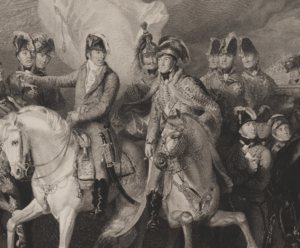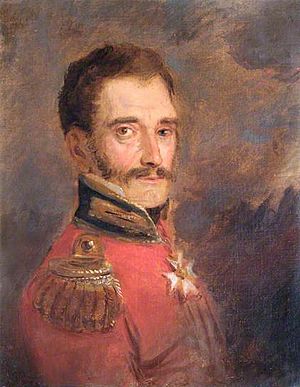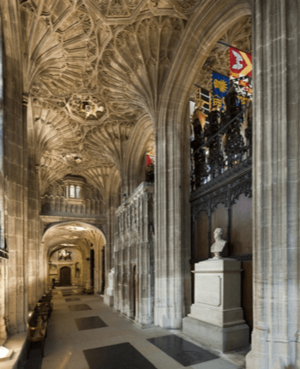John Elley facts for kids
Quick facts for kids
Sir
John Elley
KCB KCH KMT OS
|
|
|---|---|

Portrait of Sir John Elley in 1836 by William Salter
|
|
| Born | 9 January 1764 London, England |
| Died | 23 January 1839 (aged 75) Cholderton Lodge, East Cholderton, Hampshire, England |
| Buried | |
| Allegiance | United Kingdom |
| Service/ |
British Army |
| Years of service | 1789–1839 |
| Rank | Lieutenant-General |
| Unit | Royal Regiment of Horse Guards |
| Battles/wars | French Revolutionary Wars Napoleonic Wars |
| Other work | Member of Parliament for Windsor |
Lieutenant-General Sir John Elley (born January 9, 1764 – died January 23, 1839) was a brave British soldier. He started his army career as a private in the cavalry, which are soldiers who fight on horseback. Through his hard work and courage, he rose to become a high-ranking general.
Sir John Elley fought with great skill during the French Revolutionary Wars and the Napoleonic Wars. These were major conflicts that shaped Europe. After his military career, he also served as the last Governor of Galway in Ireland and became a Member of Parliament for Windsor, helping to make laws for his country.
Contents
Early Life and Army Start
Not much is known about Sir John Elley's early life, perhaps because he came from a simple background. He was born in London in 1764. His father ran a small eating-house.
When he was 25, in 1789, John Elley decided to join the army. He became a trooper in the Royal Regiment of Horse Guards. This was a famous cavalry regiment. His first military experience was in the Flanders Campaign between 1793 and 1795.
Rising Through the Ranks
John Elley quickly showed his talent in the army. He moved up from a regular soldier to an officer.
- In 1794, he became a cornet.
- In 1796, he was promoted to lieutenant.
- By 1800, he was a captain-lieutenant.
- He became a full captain in 1801.
- He was promoted to major in 1804.
- In 1806, he became a lieutenant-colonel.
Heroism at Talavera
Sir John Elley was known for his bravery. One famous story happened during the Battle of Talavera in 1809. He led a cavalry charge across unknown land. Suddenly, a deep ditch appeared in front of him. He had to jump it on his white horse while riding at full speed!
He later wrote to his sister about the battle: "I was never in more fire, nor escaped more dangers. I led one squadron to the charge as a desperate attack. Out of 80 men, I had not a dozen left. It will be great satisfaction to my good old father to know that I had a very important part in the action. I was fortunate to succeed, which greatly pleased the General Officers."
The battle lasted two days. The ground was covered with tall grass and corn. The intense artillery fire set the plants on fire. Sadly, many wounded soldiers were caught in the flames.
Courage at Vitoria
Another example of his courage happened at the Battle of Vitoria in 1813. A fellow soldier, Rees Howell Gronow, described how Sir John Elley helped save many soldiers. He gathered some dragoons (cavalry soldiers) and led a charge through the enemy.
During this charge, Sir John Elley and his horse were knocked down, and his leg was broken. Even though he was injured and constantly ridden over by both friendly and enemy soldiers, he kept cheering on his men. Eventually, he grabbed onto a sergeant's stirrup and was dragged to safety.
King George III once spoke about Sir John Elley, saying, "Fine man! Fine man! No family! No family! Fine soldier! Fine soldier!" This showed that even though Elley didn't come from a noble family, the King recognized his great military skills.

In 1815, Sir John Elley was honored as a Knight Commander of the Order of the Bath.
Waterloo Campaign
At the start of the Waterloo Campaign, Sir John Elley was a colonel in the 1st Regiment of Life Guards. He was made Deputy Adjutant-General of Cavalry. This meant he was a senior officer helping to manage the cavalry forces.
He led the charge of the Life Guards during a holding action at Genappe on July 17. This was during the British retreat from Quatre Bras to Waterloo. He was badly wounded during the main Battle of Waterloo that followed.
Sir Walter Scott, a famous writer, described Sir John Elley's actions at Waterloo: "Sir John Elley, who led the charge of the heavy cavalry, was known for his personal strength. At one point, he was surrounded by several enemy soldiers. But he was a tall and very powerful man, excellent with his sword and horse. He fought his way out, leaving several attackers on the ground with wounds that showed how strong his arm was."
After the war, on August 2, 1815, Sir John was made a Knight of the Military Order of Maria Theresa by the Emperor of Austria. On August 21, 1815, he received the Order of St. George from the Emperor of Russia. These were very high honors.
Lieutenant-General Sir Harry Smith looked up to Sir John Elley as his mentor. He shared a funny story from 1818: "Sir John Elley, a very tall, strong man with a serious face, came to Dover. He was walking with his famous sword hidden under his coat. A customs officer saw the bulge and rudely called out, 'I say, you officer, stop! What's that under your coat?' Sir John turned around, pulled out his sword, and in a booming voice, told the officer off!"
After the Wars
After the Napoleonic Wars, Sir John Elley was sent to Ireland. In August 1819, he was promoted to major-general. He was also made a Knight of the Royal Guelphic Order that same year.
He became the Commander of Connacht and then the Governor of Galway from 1826. This important position was not filled by anyone else after he passed away. In 1829, he was appointed colonel of the 17th Lancers.
At the state funeral of King George IV in 1830, Sir John Elley was among the senior army officers who helped carry the canopy over the King's body to St George's Chapel, Windsor Castle.
He was promoted to lieutenant-general on January 10, 1837.
One of his portraits, kept at the National Portrait Gallery, was painted around 1837. It was a study for a larger painting called Waterloo Banquet at Apsley House, 1836. This painting shows a special dinner hosted by the Duke of Wellington to remember the Battle of Waterloo.
Member of Parliament
In January 1835, Sir John Elley was elected as a Member of Parliament for Windsor. He was part of Robert Peel's Tory party.
In 1836, a local newspaper, the Eton & Windsor Gazette, complained about how much influence Windsor Castle had on elections. They said that many voters who worked for the Royal Establishment were told how to vote. This was believed to have helped Sir John Elley win the election, as he was often a guest at the Castle and had connections with the Court.
Death and Legacy
Sir John Elley passed away on January 23, 1839, at Cholderton Lodge in Hampshire. He was buried at St George's Chapel, Windsor Castle. His tomb has a white marble bust and an inscription. Part of it reads: "Unaided by dignity of birth, or the influence of fortune, he raised himself to the highest rank in the British Army by distinguished conduct in the field." This means he achieved his high rank through his own bravery and actions, not because he was born into a rich or powerful family.
In his will, Sir John left money and property to several people and charities. His main beneficiary was his housekeeper, Jane Carter, who received a large portion of his home's contents and a yearly payment. The Officers Mess of the Horse Guards also received money to buy special silver items.



